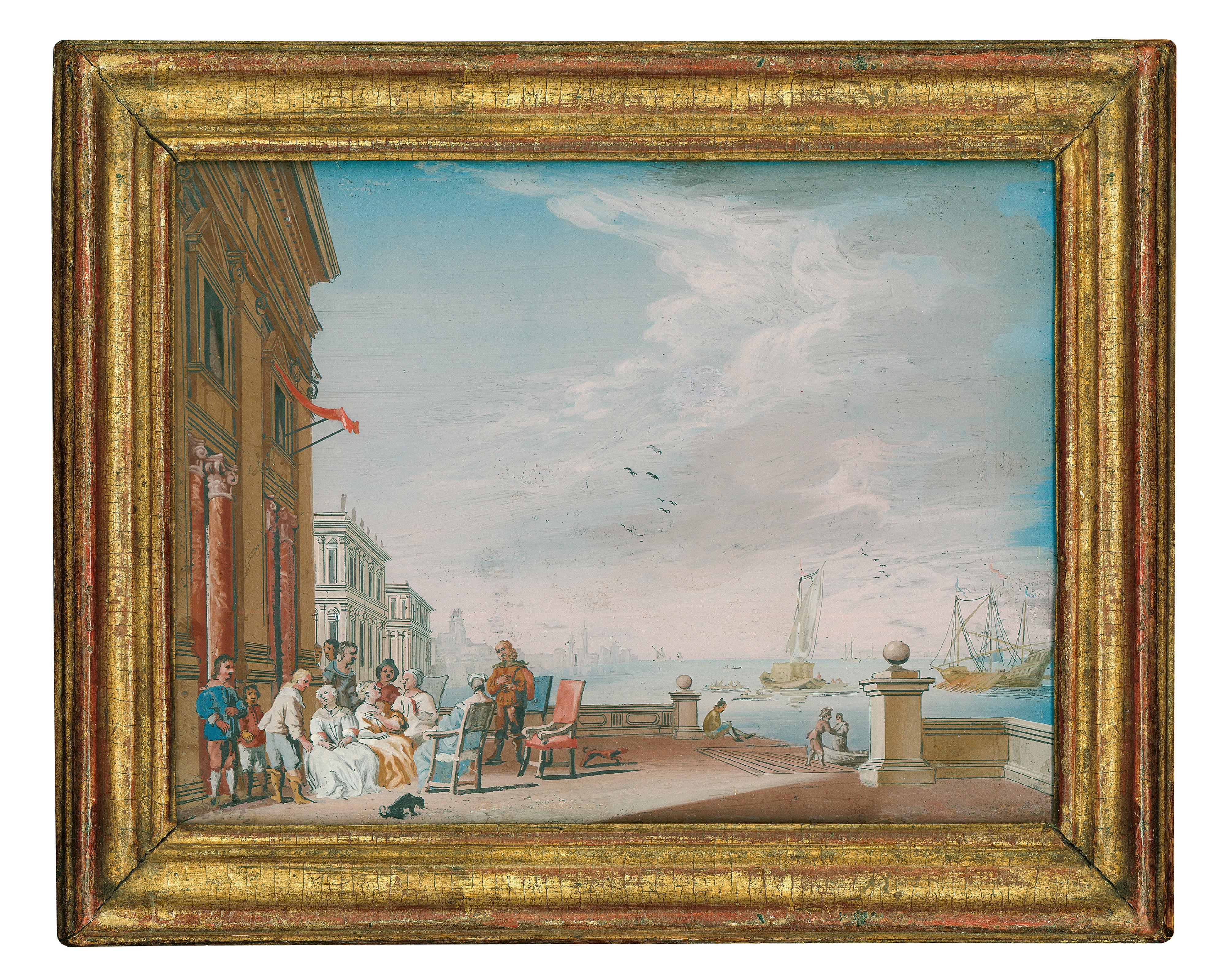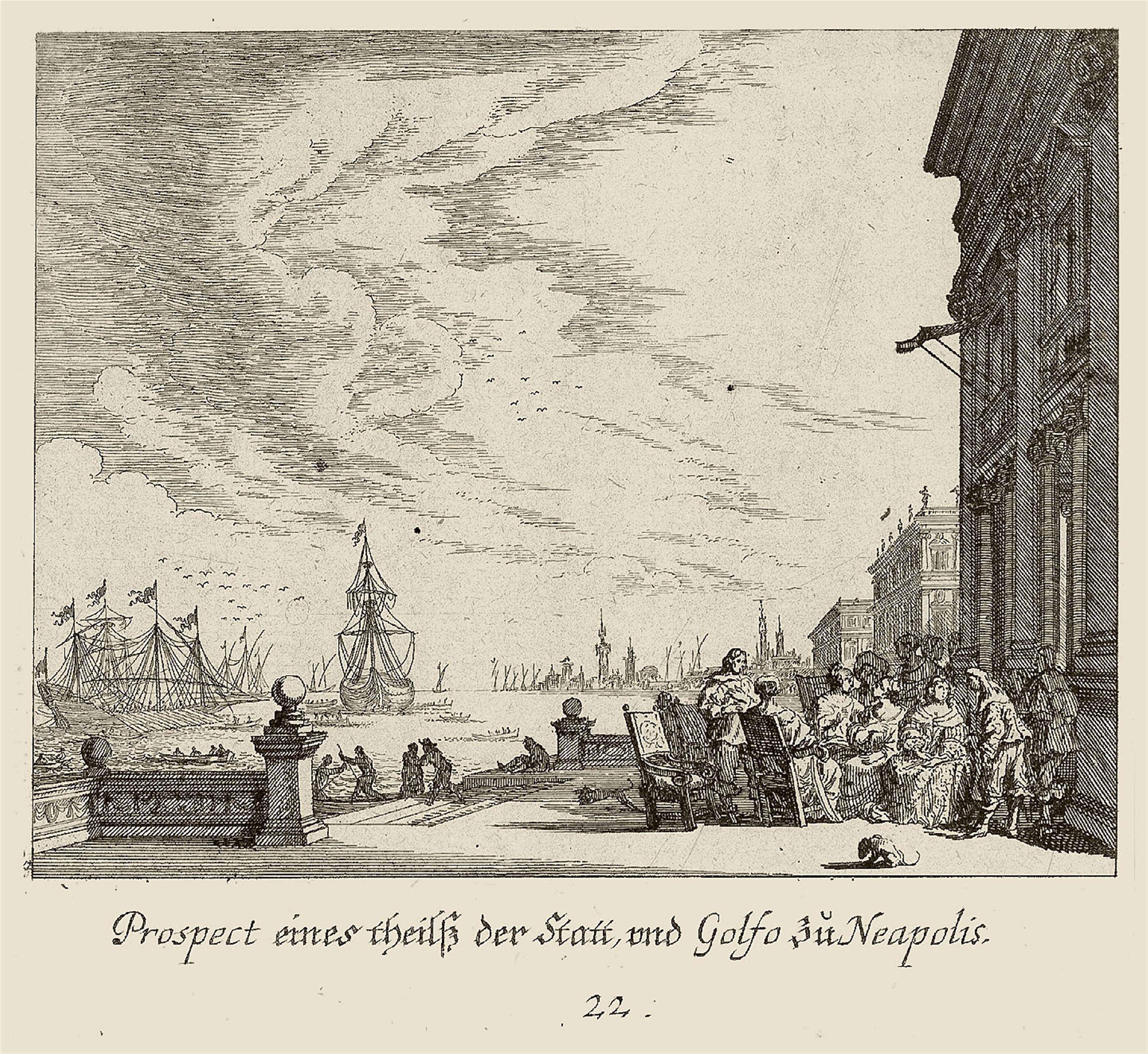Merry company on a terrace by the sea in Naples
Johann Wolfgang Baumgartner, Augsburg, around 1740.
Glass panel painted on reverse in transparent pigments with etched contours agaist black ground. Softwood frame gilded over red bole, H 26.5, W 32 cm.
Baumgartner's exceptional reverse glass painting follows a design by the Augsburg engraver and publisher Melchior Küsel (1626 - 1683), reproducing it in a mirror image. The work shown is "Prospect eines theilß der Statt, und Golfo zu Neapolis", which was sheet 21 from "Johann Wilhelm Bauren Underschidliche Prospecten Welche Er In Dennen Landen Italiae, Und Dan Auf Seiner Heim Reis. Friaul Karnten Steir. Nach Dem Leben Gezeichnet. In das Kupfer gebracht durch Melchioren Küsell zu Augspurg MDCLXXXI ". The drawing by Baur for this sheet is also known and is illustrated by Régine Bonnefoit.
Johann Wolfgang Baumgartner (1702 - 1761) was born in Kufstein in Tyrol and learnt reverse glass painting in Salzburg. In 1733 he moved to Augsburg, then one of the most important artistic centres north of the Alps. His skill and technique soon earned him a place as one of the leading glass painters. According to Paul von Stetten, he had his own special recipe for resin-based turpentine that he used to apply pigments to glass. Even after 300 years, his reverse glass paintings still remain in a remarkably good condition, displaying finely nuanced colours and the precision of an engraving, thanks to the way in which the outlines are finely etched against a black background. Baumgartner was first accepted by the Augsburg painter's guild in 1746 and was finally permitted to work in oils and fresco, which provided him with an additional source of income.
Baumgartner's most famous reverse glass paintings, his views of Paris and the Louvre over the river Seine, are today housed in the Schaezlerpalais in Augsburg. According to the current state of research, only 39 works by Johann Wolfgang Baumgartner are known to exist.
Provenance
Pocking art dealership.
Literature
Illus. in Geyssant, Peintures sous verre. Eglomisés fixés et estampes sous verre de l'antiquité à nos jours, Paris 2008, p. 120.
Illus. in Straßer, Johann Wolfgang Baumgartner 1702 – 1761 Ölskizzen und Hinterglasbilder, Salzburg 2009, cat. no. 5, p. 57.
Illus. in Haindl/Trepesch, Johann Wolfgang Baumgartner 1702 – 1761 Veduten hinter Glas, Augsburg 2012, p. 111.
Illus. in Steiner, Landschaft in der Hinterglasmalerei des 18. Jahrhunderts, Berlin-Munich 2013, illus. 78.
Cf. Ryser, Verzauberte Bilder. Die Kunst der Malerei hinter Glas, Munich 1991, p. 202 ff.
Cf. cat. Glas Glanz Farbe. Vielfalt barocker Hinterglaskunst im Europa des 17. und 18. Jahrhunderts, Murnau 1997, no. O1 - O5.
See also Bonnefoit, Unveröffentlichte Zeichnungen von Johann Wilhelm Baur im Besitz der Harvard University, in: Opere e giorni. Studi su mille anni d’arte europea dedicati a Max Seidel, Venice 2001, p. 595 ff., illus. 5.
Exhibitions
2009 Barockmuseum Salzburg.
2012 Schaezlerpalais der Kunstsammlungen und Museen Augsburg.
2012 - 2013 Maximilianmuseum Augsburg.
2013 Oberammergau Museum.




